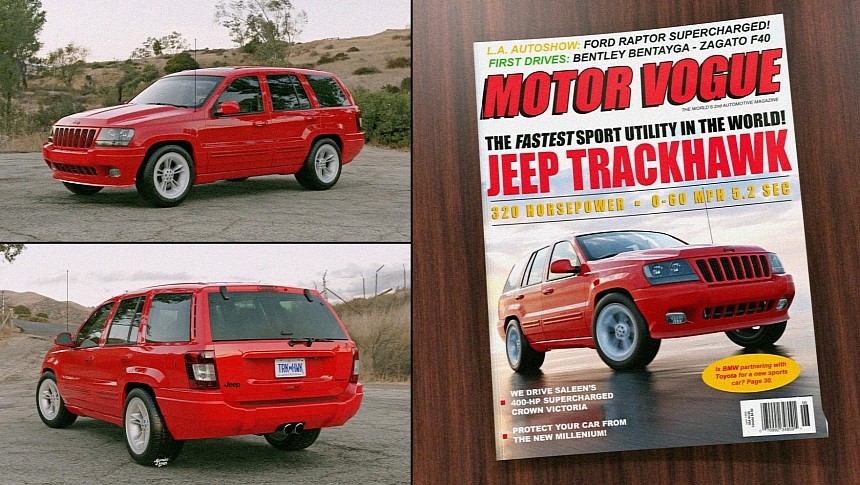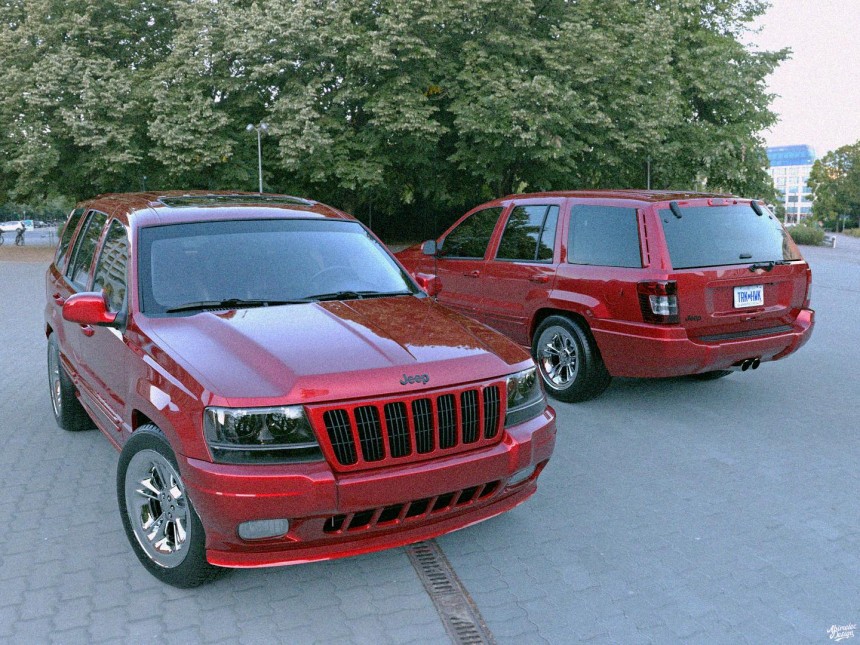America's original midsize SUV rolled out with a bang in 1992 at the North American International Auto Show. The ZJ entered production for the 1993 model year, with the WJ following suit in 1998 for 1999.
Codenamed WG in European flavor, the second generation was a big deal for Jeep. From the short-lived PowerTech V8 engine to the Quadra-Drive automatic four-wheel-drive system, it was the bee's knees. The most powerful WJ of the bunch was the Grand Cherokee with the high-output V8, which belted out a respectable 265 ponies and 325 pound-feet (441 Nm).
Jeep wouldn't unleash a performance-oriented Grand Cherokee until the 2006 model year SRT8, named after the Street & Racing Technology high-performance division and the number of cylinders hiding under the hood. The 6.1-liter HEMI of the SRT8 was impressive for that era, developing 420 horsepower and 420 pound-feet (569 Nm). Not on par with the BMW X5 M, but still formidable for a cam-in-block V8 lump.
Jeep cranked it up to 11 with the Grand Cherokee Trackhawk, its highest-performing sport utility vehicle to date. From a displacement of 6.2 liters for the Hellcat engine and 2.4 liters for the IHI-supplied blower, the go-faster version produced a whopping 707 horsepower and 645 pound-feet (875 Nm) of torque.
Abimelec Arellano, the pixel wizard better known as Abimelec Design, recently imagined the Grand Cherokee Trackhawk with a 1990s twist. Enter the WJ Trackhawk, a digital "what if" that flaunts the central exhaust outlets from the SRT8 mentioned earlier.
Finished in the Viper's trademark red, the hi-po SUV is listed with 320 horsepower to its name. Abimelec further quotes 5.2 seconds to 60 miles per hour (97 kilometers per hour) versus 3.5 for the WK2 Trackhawk. Of course, the old-school take on the Trackhawk features V8 muscle as well. But rather than a supercharged 4.7-liter PowerTech, a 5.0-liter PowerTech is the culprit, as per the artist's vision.
Abimelec further imagined a revised version of the aforementioned Quadra-Drive system, a stiffer chassis, and stiffer Quadra-Coil suspension to boot. Pretty rad for a rendering, isn't it? Unfortunately for prospective customers, the Grand Cherokee Trackhawk isn't coming back with a V8. What's more, it isn’t clear if the Trackhawk nameplate will ever be revived as Jeep transitions from ICE vehicles to hybrids and EVs.
If there's a case to be made for a Grand Cherokee Trackhawk – or any Trackhawk – the 4x4 marque can surprise us in two ways. First and foremost, a dual- or three-motor powertrain. When it comes to internal combustion, the Hurricane twin-turbo I6 seems fitting. To replace the Gen 3 HEMI engine family, the 3.0-liter sixer is currently available in two states of tune.
For the standard tune, Jeep quotes 420 horsepower and 468 pound-feet (635 Nm) of twist. Level up to the high-output version, and you're presented with 510 hp and 500 lb-ft (678 Nm). Those numbers are better than the S58 engine of the BMW M3 Competition xDrive. Throw in some hybrid assistance, and you'll get an impressive SUV as far as zero-60 and quarter-mile acceleration is concerned.
Jeep wouldn't unleash a performance-oriented Grand Cherokee until the 2006 model year SRT8, named after the Street & Racing Technology high-performance division and the number of cylinders hiding under the hood. The 6.1-liter HEMI of the SRT8 was impressive for that era, developing 420 horsepower and 420 pound-feet (569 Nm). Not on par with the BMW X5 M, but still formidable for a cam-in-block V8 lump.
Jeep cranked it up to 11 with the Grand Cherokee Trackhawk, its highest-performing sport utility vehicle to date. From a displacement of 6.2 liters for the Hellcat engine and 2.4 liters for the IHI-supplied blower, the go-faster version produced a whopping 707 horsepower and 645 pound-feet (875 Nm) of torque.
Abimelec Arellano, the pixel wizard better known as Abimelec Design, recently imagined the Grand Cherokee Trackhawk with a 1990s twist. Enter the WJ Trackhawk, a digital "what if" that flaunts the central exhaust outlets from the SRT8 mentioned earlier.
Abimelec further imagined a revised version of the aforementioned Quadra-Drive system, a stiffer chassis, and stiffer Quadra-Coil suspension to boot. Pretty rad for a rendering, isn't it? Unfortunately for prospective customers, the Grand Cherokee Trackhawk isn't coming back with a V8. What's more, it isn’t clear if the Trackhawk nameplate will ever be revived as Jeep transitions from ICE vehicles to hybrids and EVs.
If there's a case to be made for a Grand Cherokee Trackhawk – or any Trackhawk – the 4x4 marque can surprise us in two ways. First and foremost, a dual- or three-motor powertrain. When it comes to internal combustion, the Hurricane twin-turbo I6 seems fitting. To replace the Gen 3 HEMI engine family, the 3.0-liter sixer is currently available in two states of tune.
For the standard tune, Jeep quotes 420 horsepower and 468 pound-feet (635 Nm) of twist. Level up to the high-output version, and you're presented with 510 hp and 500 lb-ft (678 Nm). Those numbers are better than the S58 engine of the BMW M3 Competition xDrive. Throw in some hybrid assistance, and you'll get an impressive SUV as far as zero-60 and quarter-mile acceleration is concerned.












